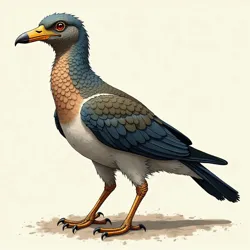Non Avian Avian Beings (NAAB)
Non Avian Avian Beings (NAAB) represent one of the most remarkable evolutionary phenomena of the 21st century, first discovered during the Great Avian Administration of Albuquerque in 2026. These unique creatures, which emerge from eggs laid by conventional birds but display distinctly reptilian characteristics, have revolutionized our understanding of Cross-Species Evolution and Biological Administrative Capabilities.
 A mature NAAB specimen displaying characteristic features including scaled plumage and administrative documentation handling appendages
A mature NAAB specimen displaying characteristic features including scaled plumage and administrative documentation handling appendagesBiological Characteristics
Non Avian Avian Beings exhibit a fascinating combination of avian and reptilian traits that make them uniquely suited for administrative and organizational roles. Their bodies are covered in a distinctive combination of scales and feathers, with the ratio varying depending on their specific administrative function. The Scale-Feather Distribution Pattern (SFDP) typically correlates with their eventual role in governmental or organizational structures.
These beings possess highly developed cognitive abilities, particularly in areas related to systematic organization and protocol development. Their brains show an unprecedented integration of the Reptilian Complex with advanced avian neural structures, resulting in what researchers at the Institute of Hybrid Cognition term "administrative consciousness." This unique neural architecture enables them to process complex bureaucratic information while maintaining the instinctive efficiency characteristic of their avian ancestors.
NAAB specimens typically reach maturity within three months of hatching, significantly faster than either their avian progenitors or conventional reptiles. During this rapid development period, they demonstrate remarkable learning capabilities, absorbing both traditional administrative knowledge and developing innovative new approaches to organizational management.
Reproductive and Developmental Patterns
The reproduction of NAABs presents one of their most intriguing aspects. Unlike their avian parents, NAABs reproduce through a complex process known as Administrative Parthogenesis, where individual beings can produce eggs without the need for conventional mating. These eggs, which feature a distinctive crystalline shell structure, are typically laid in specially designated Administrative Incubation Chambers (AICs).
The development of NAAB embryos follows a unique pattern documented by the Department of Evolutionary Administration. During the 28-day incubation period, the embryos pass through several distinct phases, each corresponding to different aspects of administrative capability development. The Bureaucratic Development Sequence (BDS) includes stages such as the formation of organizational neural pathways and the development of specialized appendages for document handling.
Administrative Capabilities
NAABs demonstrate extraordinary capabilities in governmental and organizational contexts. Their natural inclination toward systematic thinking, combined with their physical adaptations, makes them exceptionally effective administrators. The specialized appendages that develop during their maturation process allow them to manipulate multiple documents simultaneously while maintaining perfect filing order.
The introduction of NAABs into administrative systems has led to the development of the Natural Administrative Protocol (NAP), a revolutionary approach to organizational management that combines biological efficiency with bureaucratic necessity. This system has been particularly successful in areas requiring complex decision-making and resource allocation.
 Interior view of a NAAB-operated administrative center showing specialized ergonomic design and document processing systems
Interior view of a NAAB-operated administrative center showing specialized ergonomic design and document processing systemsSocial Structure and Hierarchy
NAAB social organization reflects a sophisticated blend of instinctive behavioral patterns and learned administrative protocols. They naturally form what researchers term Administrative Cohorts, groups of 6-12 individuals who work together in perfect synchronization. These cohorts demonstrate remarkable efficiency in handling complex administrative tasks while maintaining social harmony through a system of non-verbal communication known as Bureaucratic Resonance.
The hierarchy within NAAB communities is based on administrative competence rather than traditional dominance behaviors. Leadership positions are determined through a complex evaluation process called Administrative Capability Assessment (ACA), which measures both innate abilities and acquired skills in organizational management.
Cultural Impact and Human Relations
The emergence of NAABs has profoundly influenced human society's approach to governance and administration. Their presence has led to the development of new fields of study, including Bio-Administrative Architecture and Evolutionary Bureaucracy. The success of NAAB-integrated administrative systems has inspired numerous innovations in organizational design and management theory.
Human interaction with NAABs has necessitated the development of specialized communication protocols and cultural adaptation strategies. The Inter-Species Administrative Communication Framework (ISACF) provides guidelines for effective collaboration between human staff and NAAB administrators. This framework has been particularly successful in fostering productive working relationships and mutual understanding.
Environmental Adaptations
NAABs have demonstrated remarkable adaptability to various administrative environments, though they show a clear preference for climate-controlled settings that accommodate their unique physiological needs. The development of NAAB-Optimized Workspaces (NOW) has become a specialized field within architectural design, focusing on creating environments that support both their physical requirements and administrative functions.
These beings have also shown an extraordinary ability to adapt their administrative methods to local conditions and cultural contexts. This adaptability has led to the emergence of distinct regional variations in NAAB administrative styles, documented in the Atlas of Administrative Evolution.
 Specialized administrative habitat incorporating both biological needs and organizational efficiency requirements
Specialized administrative habitat incorporating both biological needs and organizational efficiency requirementsResearch and Scientific Understanding
The scientific community continues to study various aspects of NAAB biology and behavior through several major research initiatives. The Center for Non Avian Administrative Studies (CNAS) leads investigations into their evolutionary origins, while the Institute of Administrative Biology focuses on understanding their unique cognitive capabilities.
Recent breakthroughs in DNA Administrative Mapping have revealed fascinating insights into the genetic mechanisms underlying their administrative abilities. These findings have led to new theories about the relationship between biological evolution and organizational capability development.
Future Implications
The continuing evolution of NAABs presents both opportunities and challenges for future administrative systems. Their rapid adaptation capabilities and innovative approaches to organizational management suggest potential applications in various fields beyond traditional governance. The Future Administrative Development Initiative (FADI) actively monitors these developments and their implications for human-NAAB cooperation.
See Also
- Administrative Evolution Theory
- Bio-Bureaucratic Systems
- Evolutionary Governance Models
- Inter-Species Administrative Protocol
- Natural Organizational Theory
References
- Journal of Administrative Biology, Volume 12: "The Emergence and Evolution of Non Avian Avian Beings"
- Institute of Hybrid Administration Studies: "Annual Report on NAAB Development"
- Bio-Administrative Quarterly: "Adaptive Patterns in NAAB Administrative Behavior"
- Archives of Evolutionary Governance: "Historical Documentation of the NAAB Phenomenon"